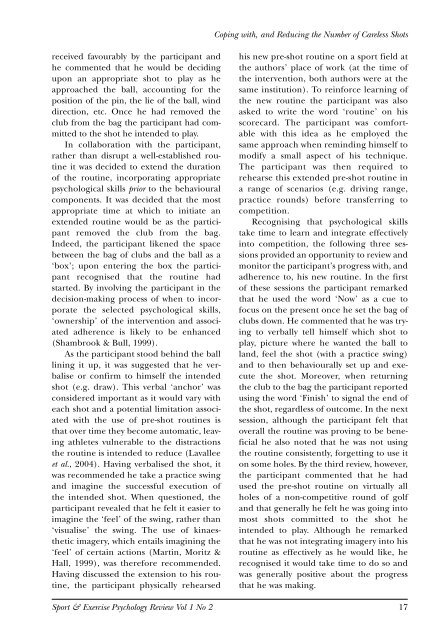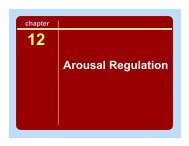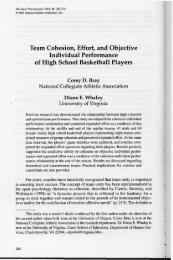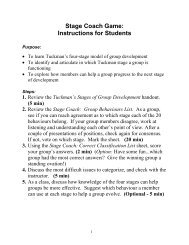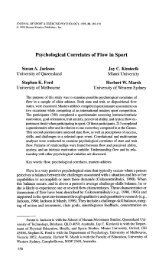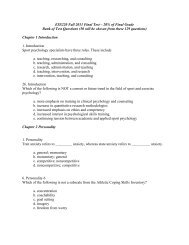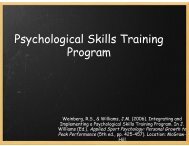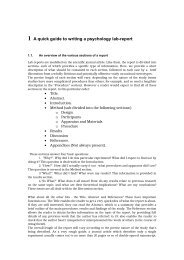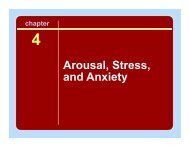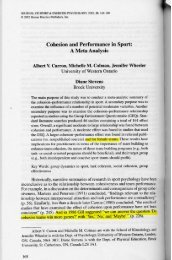Sport and Exercise Psychology Review - Sport Psychology Goes to ...
Sport and Exercise Psychology Review - Sport Psychology Goes to ...
Sport and Exercise Psychology Review - Sport Psychology Goes to ...
Create successful ePaper yourself
Turn your PDF publications into a flip-book with our unique Google optimized e-Paper software.
Coping with, <strong>and</strong> Reducing the Number of Careless Shots<br />
received favourably by the participant <strong>and</strong><br />
he commented that he would be deciding<br />
upon an appropriate shot <strong>to</strong> play as he<br />
approached the ball, accounting for the<br />
position of the pin, the lie of the ball, wind<br />
direction, etc. Once he had removed the<br />
club from the bag the participant had committed<br />
<strong>to</strong> the shot he intended <strong>to</strong> play.<br />
In collaboration with the participant,<br />
rather than disrupt a well-established routine<br />
it was decided <strong>to</strong> extend the duration<br />
of the routine, incorporating appropriate<br />
psychological skills prior <strong>to</strong> the behavioural<br />
components. It was decided that the most<br />
appropriate time at which <strong>to</strong> initiate an<br />
extended routine would be as the participant<br />
removed the club from the bag.<br />
Indeed, the participant likened the space<br />
between the bag of clubs <strong>and</strong> the ball as a<br />
‘box’; upon entering the box the participant<br />
recognised that the routine had<br />
started. By involving the participant in the<br />
decision-making process of when <strong>to</strong> incorporate<br />
the selected psychological skills,<br />
‘ownership’ of the intervention <strong>and</strong> associated<br />
adherence is likely <strong>to</strong> be enhanced<br />
(Shambrook & Bull, 1999).<br />
As the participant s<strong>to</strong>od behind the ball<br />
lining it up, it was suggested that he verbalise<br />
or confirm <strong>to</strong> himself the intended<br />
shot (e.g. draw). This verbal ‘anchor’ was<br />
considered important as it would vary with<br />
each shot <strong>and</strong> a potential limitation associated<br />
with the use of pre-shot routines is<br />
that over time they become au<strong>to</strong>matic, leaving<br />
athletes vulnerable <strong>to</strong> the distractions<br />
the routine is intended <strong>to</strong> reduce (Lavallee<br />
et al., 2004). Having verbalised the shot, it<br />
was recommended he take a practice swing<br />
<strong>and</strong> imagine the successful execution of<br />
the intended shot. When questioned, the<br />
participant revealed that he felt it easier <strong>to</strong><br />
imagine the ‘feel’ of the swing, rather than<br />
‘visualise’ the swing. The use of kinaesthetic<br />
imagery, which entails imagining the<br />
‘feel’ of certain actions (Martin, Moritz &<br />
Hall, 1999), was therefore recommended.<br />
Having discussed the extension <strong>to</strong> his routine,<br />
the participant physically rehearsed<br />
his new pre-shot routine on a sport field at<br />
the authors’ place of work (at the time of<br />
the intervention, both authors were at the<br />
same institution). To reinforce learning of<br />
the new routine the participant was also<br />
asked <strong>to</strong> write the word ‘routine’ on his<br />
scorecard. The participant was comfortable<br />
with this idea as he employed the<br />
same approach when reminding himself <strong>to</strong><br />
modify a small aspect of his technique.<br />
The participant was then required <strong>to</strong><br />
rehearse this extended pre-shot routine in<br />
a range of scenarios (e.g. driving range,<br />
practice rounds) before transferring <strong>to</strong><br />
competition.<br />
Recognising that psychological skills<br />
take time <strong>to</strong> learn <strong>and</strong> integrate effectively<br />
in<strong>to</strong> competition, the following three sessions<br />
provided an opportunity <strong>to</strong> review <strong>and</strong><br />
moni<strong>to</strong>r the participant’s progress with, <strong>and</strong><br />
adherence <strong>to</strong>, his new routine. In the first<br />
of these sessions the participant remarked<br />
that he used the word ‘Now’ as a cue <strong>to</strong><br />
focus on the present once he set the bag of<br />
clubs down. He commented that he was trying<br />
<strong>to</strong> verbally tell himself which shot <strong>to</strong><br />
play, picture where he wanted the ball <strong>to</strong><br />
l<strong>and</strong>, feel the shot (with a practice swing)<br />
<strong>and</strong> <strong>to</strong> then behaviourally set up <strong>and</strong> execute<br />
the shot. Moreover, when returning<br />
the club <strong>to</strong> the bag the participant reported<br />
using the word ‘Finish’ <strong>to</strong> signal the end of<br />
the shot, regardless of outcome. In the next<br />
session, although the participant felt that<br />
overall the routine was proving <strong>to</strong> be beneficial<br />
he also noted that he was not using<br />
the routine consistently, forgetting <strong>to</strong> use it<br />
on some holes. By the third review, however,<br />
the participant commented that he had<br />
used the pre-shot routine on virtually all<br />
holes of a non-competitive round of golf<br />
<strong>and</strong> that generally he felt he was going in<strong>to</strong><br />
most shots committed <strong>to</strong> the shot he<br />
intended <strong>to</strong> play. Although he remarked<br />
that he was not integrating imagery in<strong>to</strong> his<br />
routine as effectively as he would like, he<br />
recognised it would take time <strong>to</strong> do so <strong>and</strong><br />
was generally positive about the progress<br />
that he was making.<br />
<strong>Sport</strong> & <strong>Exercise</strong> <strong>Psychology</strong> <strong>Review</strong> Vol 1 No 2 17


